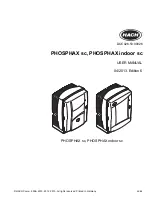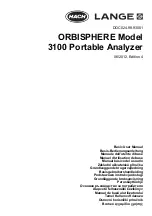
4-2
Brooks
®
Model 5851E
Section 4 Maintenance
Installation and Operation Manual
X-TMF-5851E-MFC-eng
Part Number: 541B104AAG
November, 2008
2. Verify that the process gas connections have been correctly terminated
and leak-checked.
3. If the mass flow controller appears to be functioning but cannot achieve
setpoint, verify that sufficient inlet pressure and pressure drop are
available at the controller to provide the required flow.
4. Verify that all user selectable jumpers are in their desired positions
(refer to Figs. 3-3 and 3-4).
Any Brooks Instrument mass flow meter or flow controller with a 15
pin D-Connector PC Board bearing the "CE Mark" must use a 100%
shielded cable and metal shell mating connectors. The shield is
tied over 360 degrees to the shell at both ends. This is mandatory
to be in compliance with the EMC Directive (89/336/EEC). Refer to
Appendix A.
CAUTION
B. Bench Troubleshooting
1. Properly connect the mass flow controller to a ±15 Vdc power supply
command voltage source and connect an output signal readout device
(4-1/2 digit voltmeter recommended) to Terminals 2 and 3 or D-Con-
nector Pins 2 and 10 (refer to Figs. 2-2 and 2-3). Apply power, set the
command voltage to zero and allow the controller to warm-up for 15
minutes. Do not connect to a gas source at this time.
Observe the output signal and, if necessary, perform the zero adjust-
ment procedure (Section 3-3). If the output signal will not zero properly,
refer to the sensor troubleshooting section and check the sensor. If the
sensor is electrically functional, the printed circuit board is defective and
will require replacement.
2. Connect the controller to a source of the gas on which it was originally
calibrated. Command 100% flow and adjust the inlet and outlet pres-
sures to the calibration conditions. Verify that the output signal reaches
and stabilizes at 5.000 Volts. Vary the command voltage over the 2 to
100% range and verify that the output signal follows the setpoint.
Apply +15 Volts to the valve override input (refer to Figs. 2-3 and 2-4 for
terminal assignments) and verify that the output exceeds 5.000 Volts.
Apply -15 Volts to the valve override terminal and verify that the output
signal falls below 0.100 Volts. If possible, connect a flow measurement
device in series with the mass flow controller to observe the actual flow
behavior and verify the accuracy of the mass flow controller. If the mass
flow controller functions as described above, it is functioning properly
and the problem is most likely elsewhere. Table 4-1 lists possible
malfunctions which may be encountered during bench troubleshooting.
C. Sensor Troubleshooting
If it is believed the sensor coils are either open or shorted, troubleshoot
using Table 4-2. If any of the steps do not produce expected results, the
sensor assembly is defective and must be replaced. Refer to Section 4-4
for the disassembly and assembly procedures to use when replacing the
sensor.
















































